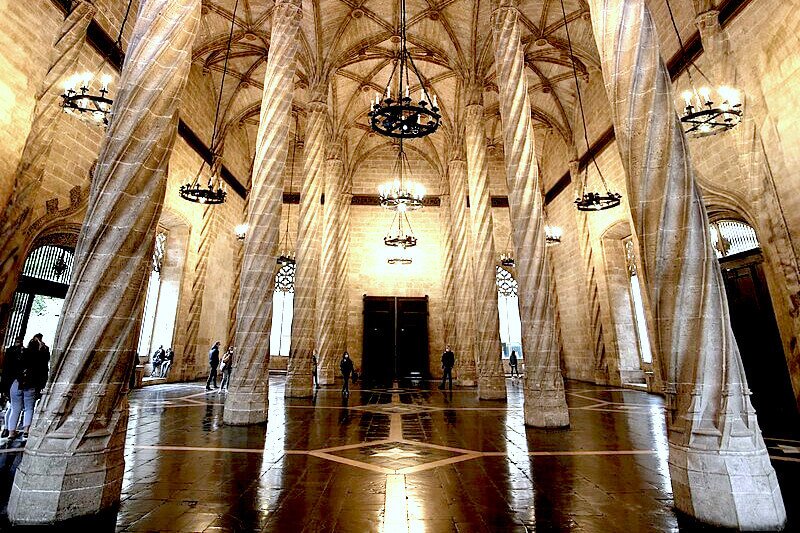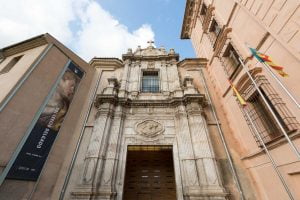The Silk Exchange in Valencia, also known as La Lonja de los Mercaderes, is one of the most outstanding architectural jewels of Valencia and a symbol of the economic and cultural splendor of the city during the Middle Ages.
Declared a World Heritage Site by UNESCO in 1996, this majestic building not only represents an exceptional testimony of civil Gothic architecture, but is also a reflection of the rise of the silk trade in medieval Europe.
In this article, we will explore the fascinating history of the Lonja de la Seda in Valencia, its impressive architecture, and its significant contribution to the cultural and economic heritage of Valencia.
In addition, we will offer practical advice for those who wish to visit this emblematic monument, turning your visit into an unforgettable experience.
History of the Silk Exchange
History of the Lonja de la SedaThe construction of the Lonja de la Seda began in 1482 and ended in 1548, during the economic boom of Valencia in the 15th century, a time in which the city established itself as one of the most important commercial centers. from the Mediterranean.
The initiative for its construction was taken by the Consulate of the Sea, a commercial institution that regulated commerce in the city. The design was commissioned by architect Pere Compte, who adopted a civil Gothic style that reflected the prosperity and power of the city.
Over the centuries, the Silk Exchange has maintained its original function of being a center of trade and business, although it has also played other roles. During the early modern period, the building remained a key location for the trade of silk and other valuable products.
In the 18th century, the Lonja underwent some minor modifications, but its main structure and central function remained unchanged.
In the 19th century, with modernization and changes in trade routes, the importance of La Lonja as a commercial center decreased. However, its historical and architectural value began to be increasingly recognized, leading to conservation and restoration efforts.
The construction of the Silk Exchange is part of a golden era for Valencia, known as the Valencian Golden Age. During this period, the city benefited greatly from maritime trade, thanks to its strategic location in the Mediterranean.
The silk trade was particularly important, making Valencia a nerve center on the Silk Road in Europe.
The Lonja de la Seda not only served as a market, but also as a meeting point for merchants and bankers, thus consolidating Valencia’s role in international trade.




Architecture and design of La Lonja de la Seda in Valencia
The Silk Exchange is a magnificent example of civil Gothic architecture, a style that flourished in Europe during the Late Middle Ages and is characterized by its monumentality and the sophistication of its decorative elements.
This style moves away from religious Gothic, oriented towards spirituality, to focus on functionality and the representation of civil and economic power.
Main architectural elements
The Silk Exchange is made up of several notable architectural elements, each with unique characteristics that contribute to its grandeur and beauty:
- Columnar Hall (Contracting Hall): This is the heart of the building and is considered a masterpiece of civil Gothic. It consists of a large rectangular space supported by fine helical columns that rise to form cross vaults. The room conveys a feeling of spaciousness and lightness, despite its solid stone construction.
- The Tower: Located in a corner of the building, the tower has a defensive and storage function. Inside, it houses a spiral staircase that leads to the different levels, including a jail on the upper floor, where debtors were held.
- Consulate of the Sea: This annex building was added in the 16th century and served as the headquarters of the Court of the Consulate of the Sea, which regulated commercial and maritime activities. Its design combines Gothic elements with Renaissance details, showing the transition between these two styles.
- Patio de los Naranjos: This charming open space connects the different buildings of the Lonja and is adorned with orange trees, an emblematic plant of Valencia. The courtyard offers a quiet respite in the middle of the complex and highlights the connection between nature and architecture.
Interior and exterior
Interior: Inside the Lonja, in addition to the impressive Column Hall, you can see exquisite decorations on the doors, windows and ceilings, with intricate carvings and floral motifs that reflect the skill of the artisans of the time.
Gargoyles and heraldic shields also adorn the interior, providing symbolic and decorative details.
Exterior: The facade of the Lonja is equally impressive, with large Gothic windows, pinnacles, and battlements that give it an air of fortress.
The richly decorated main doors display allegorical scenes and figures related to trade and justice.
Taken together, the architecture and design of the Lonja de la Seda not only reflect the style and construction techniques of Civil Gothic, but also the prosperity and cultural sophistication of medieval Valencia.
Every detail, from the columns to the gargoyles, speaks of the economic power and commercial relevance of the city in its golden age.
Visiting the Silk Exchange
Location
The Silk Exchange (La Lonja de la Seda) is located in the heart of Valencia, at Pl. del Mercado, s/n, CP 46001 – València. This central location makes it easily accessible from anywhere in the city and an essential destination for any visitor.
Contact information
For any inquiries or additional information, you can contact through the following means:
- Phone: 962 084 153
- Email: lonja@valencia.es
- Alternate Email: museos@valencia.es
Additionally, you can find more information on the official website of the Silk Exchange and the Consulate of the Sea.
Ticket Sales
Tickets to visit the Silk Exchange can be purchased online through the ticket sales portal, which is highly recommended to avoid queues and secure your visit.
Visiting hours
- Monday to Saturday: From 10:00 to 19:00 (Last entry 30 minutes before closing).
- Sundays and Holidays: From 10:00 to 14:00.
The Silk Exchange is closed on the following dates:
- January 1st and 6th.
- May 1st.
- December 25th.
Guided Tours of the Tower
From November 16, 2023, to June 2024, free guided tours of the Silk Exchange tower are offered every Thursday, Saturday, and Sunday at the following times: 11:00, 12:00, and 13:00. These tours last approximately 30 minutes and are conducted in Valencian/Spanish and English.
To participate in these tours, a prior reservation is required by calling 695500290 (phone service from Monday to Friday, 9:00 to 18:00). Each call allows up to four registrations. Participants must present themselves at the Silk Exchange reception 10 minutes before the tour starts.
What to See and Do at the Silk Exchange
- Explore the Hall of Columns: Admire the impressive helicoidal columns and ribbed vaults that give this space a unique atmosphere.
- Visit the Consulate of the Sea: Learn about the history of this important mercantile institution and enjoy the Renaissance architectural details.
- Enjoy the Orange Tree Courtyard: Relax in this charming courtyard while appreciating the connection between nature and architecture.
- Climb the Tower: Take advantage of the guided tours to enjoy a panoramic view of Valencia from the tower.
Special Events and Activities
The Silk Exchange also hosts cultural events, temporary exhibitions, and educational activities. These events vary throughout the year, so it is recommended to check the official website or contact directly for updated information on the activities scheduled during your visit.
Visiting the Silk Exchange is an experience that will allow you to immerse yourself in the rich history and culture of Valencia while enjoying one of the city’s most important architectural wonders.
Tips for planning your visit
Valencia enjoys a Mediterranean climate with mild winters and hot summers. The best times to visit the Silk Exchange are in the spring (March to May) and fall (September to November) when temperatures are more comfortable and the city is less crowded with tourists. These periods also coincide with various local festivals, such as Las Fallas in March, adding an extra cultural appeal to your visit.
Suggested itineraries in Valencia including the silk exchange
To make the most of your visit to the Silk Exchange and its surroundings, here are some suggested itineraries:
Half-Day Itinerary:
- Morning: Start your day with a visit to the Silk Exchange. Be sure to explore the Hall of Columns, the Consulate of the Sea, and the Orange Tree Courtyard.
- Afternoon: After the visit, head to the Central Market, just across from the Silk Exchange. Enjoy lunch with fresh local products.
Full-Day Itinerary:
- Morning: Begin your tour at the Silk Exchange. Afterward, visit the Central Market and enjoy lunch.
- Afternoon: Walk towards Plaza de la Reina and visit the Valencia Cathedral and the Miguelete tower. Then, relax at the Turia Gardens, the former riverbed turned into a vast urban park.
- Evening: Have dinner at one of the restaurants in the Carmen neighborhood, known for its nightlife and bohemian atmosphere.
Weekend Itinerary:
- Day 1: Visit the Silk Exchange, Central Market, and Valencia Cathedral. In the afternoon, explore the Turia Gardens and the Bioparc.
- Day 2: Spend the day at the City of Arts and Sciences. In the afternoon, enjoy Valencia’s beaches and dinner on the seafront promenade.
Other nearby attractions
Valencia is full of architectural, cultural, and natural wonders. Here are some nearby attractions to the Silk Exchange:
- Central Market: One of the largest markets in Europe, located right across from the Silk Exchange. It’s a great place to sample local products.
- Church of Santos Juanes: Next to the Central Market, this baroque church is known for its rich decoration.
- Plaza Redonda: A curious circular square filled with small craft shops and bars. It’s ideal for a relaxed stroll.
- Silk Museum: A few streets from the Silk Exchange, this museum offers a deeper look into Valencia’s silk industry.
- Carmen Neighborhood: A historic neighborhood with narrow streets, bars, restaurants, and vintage shops. Perfect for exploring after visiting the Silk Exchange.
Planning your visit to the Silk Exchange and its surroundings will allow you to immerse yourself in Valencia’s rich history and culture, making your trip an unforgettable experience.
Plan a guided visit to the Lonja de la Seda (Silk Exchange)
Are you ready to discover the wonders of Valencia with expert guidance?
Let MPC Travel Spain be your trusted companion on your journey through this enchanting city. Our team of experienced tour guides will ensure you have an unforgettable experience, delving into Valencia’s rich history, vibrant culture, and hidden gems.
Whether you’re exploring the iconic landmarks like the Silk Exchange or uncovering the city’s best-kept secrets, we’re here to make your visit truly memorable.
Contact us today to plan your personalized tour and embark on the adventure of a lifetime with MPC Travel Spain.
Recommended Information
Ready to embark on your dream vacation? Contact us today to start planning your unforgettable journey through the beautiful regions of Andalusia and the Valencian Community!




